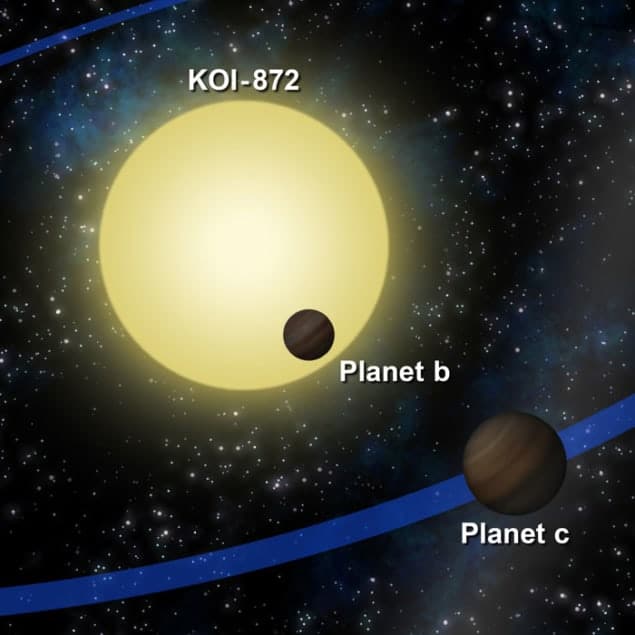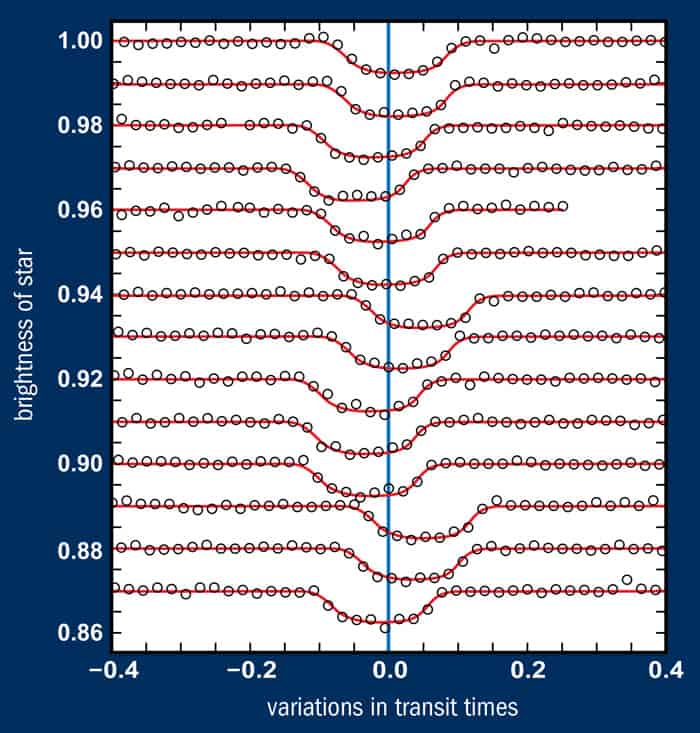
An international team of researchers has detected and characterized an “unseen” exoplanet, simply by looking at its gravitational effects on the orbit of another exoplanet within the same system. While the technique has been used before to confirm the existence of certain exoplanets found using other methods, this is the first time it has been used to discover an exoplanet.
NASA’s Kepler mission is currently looking at more than 15,000 stars, any of which could harbour their own planetary systems. Kepler looks for small dips in a star’s brightness as a function of time – its light curve – that would occur when a planet crosses the face of the star in a “transit”. It also looks for changes in the radial velocity of the star itself – the tiny shifts that occur because of the gravitational pull of a planet. In 2005 two different groups of researchers outlined a method that could help find exoplanets – especially very small ones – for which radial-velocity data are inconclusive and the transits of which are not visible from Kepler’s vantage point. The method focuses on irregularities in the patterns and transit timings of known exoplanets – dubbed “transit-time variations”.
Predicted twists
A lone exoplanet following a strict Keplerian orbit around its parent star would show an equally spaced and timed transit light curve that is periodic. Any variation in this could mean that the exoplanet is not alone – it may have a moon or there may be other unseen exoplanets in the system. Since the method was proposed, the Kepler team has used it to confirm its data in a number of systems where exoplanets did show their transits, rather than as a method to discover hidden exoplanets.
It is only now that an analysis of publicly available Kepler data has allowed David Nesvorny of Southwest Research Institute in Boulder, Colorado, and colleagues to successfully identify and characterize an exoplanet in a system previously thought to contain only one exoplanet. “We had been looking at hundreds of systems that could host possible exoplanets as identified by Kepler – each is known as a ‘Kepler Object of Interest’ [KOI] – and this one in particular seemed the best candidate as it showed a huge transit-time variation of almost two hours and was not periodic at all,” explains Nesvorny. The team looked at the data from 15 transits of the known exoplanet-b that has an orbit of 33.6 days around its parent star – known as KOI-872 – and then ran complex computer simulations to allow for all possible solutions that could cause the variations.
Hidden effects
The researchers found that the best solution for the gravitational perturbations seen for exoplanet-b is the existence of another near-by exoplanet, exoplanet-c, that orbits the parent star every 57 days. According to Nesvorny, the data supporting the existence of exoplanet-c are “very convincing and have a statistical significance of better than 3σ”. To put their findings to the test, the researchers have predicted the timing variations for numerous upcoming transits of exoplanet-b. Some of the data for this are already available to the Kepler team, while other data that be collected over the next three years. “The Kepler team can check for the predicted trend and they can even check for whatever faint radial-velocity data it can get for the effect of the other exoplanet in the system to test our predictions,” says Nesvorny.
Unexpected addition
As it turns out, soon after the researchers predicted exoplanet-c, a third exoplanet – a super-Earth approximately 1.7 times the mass of the Earth and with a very short orbit of 6.8 days – was found in transit data from Kepler. So could it be that this third exoplanet has an equal or greater effect on exoplanet-b? “We did immediately test for that too, but our simulations showed that for a smallish exoplanet like the super-Earth, its gravitational effects would be in the order of minutes and not hours. Of course, there is a chance that the super-Earth is extremely dense or that exoplanet-c is extremely light, but the chances of that are slim. For the observed two-hour transit-time variation, the super-Earth would have to almost be as dense as a neutron star, which is not going to be the case,” says Nesvorny. So the team is sticking to its original prediction for exoplanet-c.
In the months to come, Nesvorny and the team will be looking at more data from the Kepler mission to prove their predictions. Nesvorny, who is also part of the Hunt for the Exomoons with Kepler (HEK) project, will be looking at data on transit-tiem variations to search for exomoons. “Exomoons are the next big thing, I feel,” says Nesvorny. “They help determine the mass of an exoplanet and could be situated within the habitable zone of a star and be as interesting as their parent planets,” he says.
The research will be published in Science.




